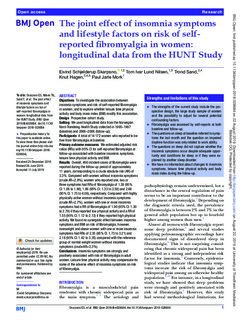| dc.contributor.author | Skarpsno, Eivind S. | |
| dc.contributor.author | Nilsen, Tom Ivar Lund | |
| dc.contributor.author | Sand, Trond | |
| dc.contributor.author | Hagen, Knut | |
| dc.contributor.author | Mork, Paul Jarle | |
| dc.date.accessioned | 2019-08-27T11:59:29Z | |
| dc.date.available | 2019-08-27T11:59:29Z | |
| dc.date.created | 2019-08-23T09:03:58Z | |
| dc.date.issued | 2019 | |
| dc.identifier.issn | 2044-6055 | |
| dc.identifier.uri | http://hdl.handle.net/11250/2611206 | |
| dc.description.abstract | Objectives To investigate the association between insomnia symptoms and risk of self-reported fibromyalgia in women, and to explore whether leisure time physical activity and body mass index (BMI) modify this association.
Design Prospective cohort study.
Setting We used longitudinal data from the Norwegian Nord-Trøndelag Health Study collected in 1995–1997 (baseline) and 2006–2008 (follow-up).
Participants A total of 14 172 women who reported to be free from fibromyalgia at baseline.
Primary outcome measures We estimated adjusted risk ratios (RRs) with 95% CI for self-reported fibromyalgia at follow-up associated with baseline insomnia symptoms, leisure time physical activity and BMI.
Results Overall, 466 incident cases of fibromyalgia were reported during the follow-up period of approximately 11 years, corresponding to a crude absolute risk (AR) of 3.3%. Compared with women without insomnia symptoms (crude AR=2.8%), women who reported one, two or three symptoms had RRs of fibromyalgia of 1.39 (95% CI: 1.08 to 1.80), 1.86 (95% CI: 1.33 to 2.59) and 2.66 (95% CI: 1.75 to 4.06), respectively. Compared with highly physically active women without insomnia symptoms (crude AR=2.7%), women with one or more insomnia symptoms had a RR of fibromyalgia of 1.90 (95% CI: 1.30 to 2.79) if they reported low physical activity and a RR of 1.55 (95% CI: 1.12 to 2.13) if they reported high physical activity. We found no synergistic effect between insomnia symptoms and BMI on risk of fibromyalgia; however, overweight and obese women with one or more insomnia symptoms had RRs of 2.35 (95% CI: 1.73 to 3.21) and 2.18 (95% CI: 1.42 to 3.35) compared with the reference group of normal weight women without insomnia symptoms (crude AR=2.3%).
Conclusions Insomnia symptoms are strongly and positively associated with risk of fibromyalgia in adult women. Leisure time physical activity may compensate for some of the adverse effect of insomnia symptoms on risk of fibromyalgia. | nb_NO |
| dc.language.iso | eng | nb_NO |
| dc.publisher | BMJ Publishing Group | nb_NO |
| dc.rights | Navngivelse-Ikkekommersiell 4.0 Internasjonal | * |
| dc.rights.uri | http://creativecommons.org/licenses/by-nc/4.0/deed.no | * |
| dc.title | The joint effect of insomnia symptoms and lifestyle factors on risk of self-reported fibromyalgia in women: longitudinal data from the HUNT Study | nb_NO |
| dc.type | Journal article | nb_NO |
| dc.type | Peer reviewed | nb_NO |
| dc.description.version | publishedVersion | nb_NO |
| dc.source.journal | BMJ Open | nb_NO |
| dc.identifier.doi | 10.1136/bmjopen-2018-028684 | |
| dc.identifier.cristin | 1718177 | |
| dc.description.localcode | © Author(s) (or their employer(s)) 2019. Re-use permitted under CC BY-NC. No commercial re-use. See rights and permissions. Published by BMJ. | nb_NO |
| cristin.unitcode | 194,65,20,0 | |
| cristin.unitcode | 194,65,30,0 | |
| cristin.unitname | Institutt for samfunnsmedisin og sykepleie | |
| cristin.unitname | Institutt for nevromedisin og bevegelsesvitenskap | |
| cristin.ispublished | true | |
| cristin.fulltext | original | |
| cristin.qualitycode | 1 | |

